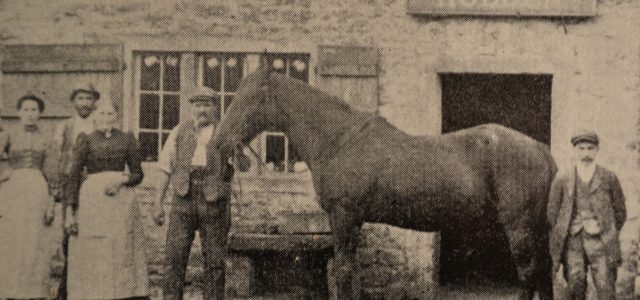
HOLDEN PAST AND PRESENT
Keen historian Andrew Stachulski delves into the past and discovers some little known facts surrounding the pretty Ribble Valley hamlet of Holden
‘We have lost too much of the past out of concern for the present,’ said Alfred Wainwright in his thought-provoking manner. He certainly had a point. But we do not have to lose the past – it is largely up to us. Carefully preserved records, remembered characters and telling photographs can take us back over the generations, both informing and entertaining.
The history of Holden is a case in point. For too long, Holden has played second fiddle to its neighbour, Bolton-by-Bowland, but in truth it carries its own fascinating story. Richard Milne-Redhead’s book, ‘Recollections of a Country Gentleman’, published in 1977, is a classic of its kind.
Mr Milne-Redhead lived with his family for many years in the fine old house of Holden Clough, initially when nearby Bolton Hall was in its heyday under the Wrights. Holden Clough is still occupied today, and has given its name to the very popular Holden Clough Nurseries – how fitting, onsidering that gardening was the great love of Richard’s life. The old house lies about a third of a mile along a track by Holden Brook, near the junction of the Slaidburn and Lane Ends roads.
Holden chapel, a continuing witness to the strong northern chapel tradition, lies on the Lane Ends road to the west of the village. Richard records a lease dating from 1766 granting the building of a chapel, and a minister was indeed in place from that date, though there was no manse until the 1770s. The chapel is splendidly kept, inside and outside, and maintains a loyal congregation. The view from its modest elevation is most attractive, looking east across old woodlands into the mid-Ribble Valley. You can find some fine old photographs of the chapel on the internet, of old weddings and special services held here. Associated with the chapel from at least 1790, were three so-called ‘poor cottages’ (Ladycroft), in effect almshouses, situated down the road by the old smithy.
The Dickensian spectre of the workhouse, with all its grim connotations, is not one you would readily associate with this pleasant rural location. Nevertheless, Holden was indeed the site of the Clitheroe workhouse in the 19th century, from about 1832 to 1873, using a former mill by the side of Holden Brook. A published audit (1866) of the conditions inside does not make impressive reading with ‘some old, irregular, and dilapidated premises’ – especially regarding the sanitation. There is little to be proud of in this aspect of Victorian society, though the audit does concede that the management of Holden workhouse was acceptable: ‘The inmates appear to be clean, well fed, and generally contented with their condition’.
Later the workhouse was moved to Chatburn Road, Clitheroe, eventually becoming Clitheroe Community Hospital, demolished in 2017. The Holden building stood near the junction of roads in the village centre – a narrow ginnel rising to the upper Slaidburn road was adjacent to the old building and can still be seen.
The old village shops, within living memory for some, evoke pleasanter memories. A noted family-run grocery, Dugdales, dating from about 1872, lay at the main road junction with a dairy opposite. A fine old photograph can be traced on the internet, probably dating from about 1910, showing the family with their horse by the shop front. In its heyday, the shop was a significant retail outlet and served a wide area, including regular deliveries as far as Burnley. Dugdale is a prevalent family name hereabouts, as you can readily see from parish and school records. When Mrs Dugdale died in 1916, the business was discontinued, but a Co-op was situated in the village until 1942 in a simple wooden building, near the modern garden centre.
Holden never had its own village school, though possibly a few children were educated by the local minister in a building adjoining the chapel. Later the village children attended either the school at Bolton-by-Bowland or the one at Lane Ends, about one and a half miles west of the village. Even within this author’s memory, up to the 1960s, there was a Ribble bus service linking Lane Ends School with the two villages. There is a splendid written record of Lane Ends School, with class photographs dating back to around 1900.
Bringing us back to the beginning, Bolton-by-Bowland School now stands by the charming village green near the courthouse, making a most pleasing impression. It was Richard’s grandfather who was largely responsible for establishing the green in its present form.
I have to acknowledge the help of Daphne Milne-Redhead and her sister Anthea in preparing this article, for the booklet giving the history of Lane Ends School, and for access to the photos of the chapel. To speak with them, and walk through Holden, is an education. Every house, the bridge over the brook, remnants of old walls here and there – but above all, the memories of old friends, bringing the past to life. Daphne’s own memories and collected writings, amplifying her father’s book, will be duly preserved. Indeed I have only touched on a few topics here. I also thank Geoff Bowker for the loan of his copy of the ‘Recollections’. Next time you visit Holden, visiting Holden Clough Nurseries perhaps, why not do some exploring for yourself? There are so many avenues for the enquiring mind here.

